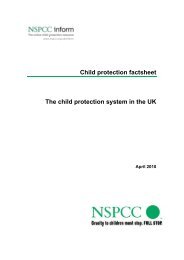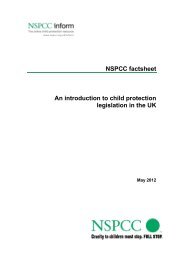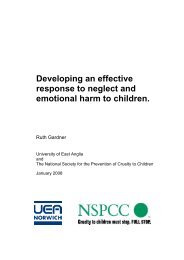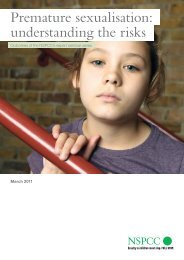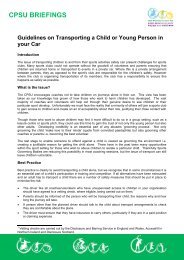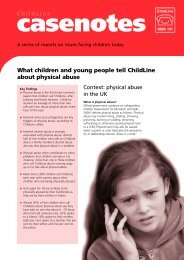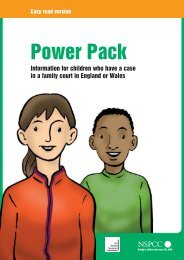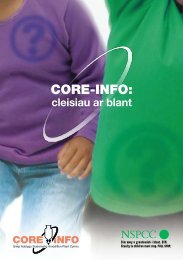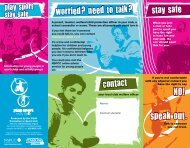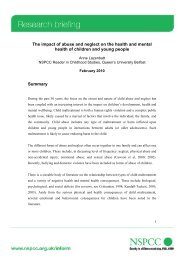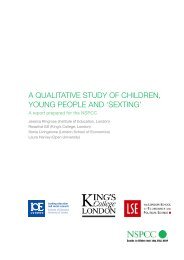Neglect and serious case reviews (PDF, 735KB) - nspcc
Neglect and serious case reviews (PDF, 735KB) - nspcc
Neglect and serious case reviews (PDF, 735KB) - nspcc
You also want an ePaper? Increase the reach of your titles
YUMPU automatically turns print PDFs into web optimized ePapers that Google loves.
3. A thematic analysis of neglect<br />
harm. The final category considers the longer term consequences of living with neglect<br />
when the young person takes their own life.<br />
1. Malnutrition: Extreme deprivation by withholding food or water from the child,<br />
where the child died or was close to death (8 <strong>case</strong>s).<br />
2. Medical neglect: The child died or was <strong>serious</strong>ly harmed or nearly died because the<br />
parents did not comply with medical advice or administer medications (5 <strong>case</strong>s).<br />
3. ‘Accidents’ with some elements of forewarning: Accidents, both fatal <strong>and</strong> resulting<br />
in <strong>serious</strong> harm, occurred within a context of chronic, long-term neglect, lack of<br />
supervision, <strong>and</strong> an unsafe environment (9 <strong>case</strong>s).<br />
4. Sudden unexpected death in infancy: Unexplained infant deaths within a context of<br />
neglectful care <strong>and</strong> a hazardous home environment (10 <strong>case</strong>s).<br />
5. Physical abuse combined with neglect: Physical assault, both fatal <strong>and</strong> resulting in<br />
very <strong>serious</strong> injury, in a context of chronic, neglectful care, where the assumptions<br />
about neglect masked this danger to the life of the child (7 <strong>case</strong>s).<br />
6. Suicide of a young person: A long-term history of neglect or extreme isolation<br />
having a catastrophic impact on the young person’s mental wellbeing (7 <strong>case</strong>s).<br />
These six themes were drawn from the <strong>case</strong>s <strong>and</strong> not constructed from the definition in<br />
Working Together (HM Govt. 2010). However it is interesting how closely they connect<br />
with this official definition, with the exception of the theme of physical abuse combined<br />
with neglect. Another difference is ‘accidents’ with elements of forewarning which<br />
similarly do not feature in Working Together.<br />
Having established this framework, further analytical work was then undertaken,<br />
examining <strong>case</strong>s applicable to each category. The selection of <strong>case</strong>s was based on<br />
pragmatic consideration about the availability of source documents <strong>and</strong> also on their<br />
relevance to each of the identified themes. Analysis involved both revisiting previously<br />
completed <strong>case</strong> summaries where neglect was prominent (for 2003–09) <strong>and</strong> creation<br />
of new summaries for SCRs from 2009–11. The <strong>case</strong> summary structure included an<br />
outline of the <strong>case</strong>, the child <strong>and</strong> family background, the child’s experience, agency<br />
involvement, <strong>and</strong> lessons learned.<br />
Four researchers were involved in the analysis, <strong>and</strong> regular team meetings were held<br />
to discuss <strong>and</strong> identify emerging themes. Results are presented in the form of <strong>case</strong><br />
vignettes. Care was taken to change identifying details <strong>and</strong> to use a combination of<br />
sources, so that each vignette was based on a number of <strong>case</strong>s which shared similar<br />
features. Thus each vignette, as presented, is a composite but credible <strong>case</strong>, <strong>and</strong> the<br />
actions, circumstances <strong>and</strong> agency responses do not refer exclusively to the history of<br />
any one child. Instead they allow for the investigation of key themes, in a manner which<br />
41




